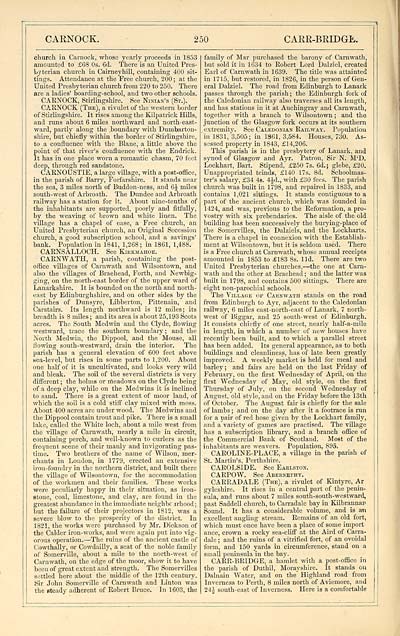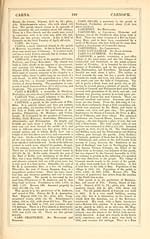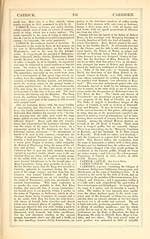Download files
Complete book:
Individual page:
Thumbnail gallery: Grid view | List view

CAENOCK.
250
CAEE-BEIDGL.
church in Carnock, whose yearly proceeds in 1853
amounted to £68 0s. 6d. There is an United Pres-
byterian church in Cairneyhill, containing 400 sit-
tings. Attendance at the Free church, 200 ; at the
United Presbyterian church from 220 to 250. There
are a ladies' boarding-school, and two other schools.
CAENOCK, Stirlingshire. See Ninian's (St.).
CARNOCK (The), a rivulet of the western border
of Stirlingshire. It rises among the Kilpatrick Hills,
and runs about 6 miles northward and north- east-
ward, partly along the boundary with Dumbarton-
shire, but chiefly within the border of Stirlingshire,
to a confluence with the Blane, a little above the
point of that river's confluence with the Endrick.
It has in one place worn a romantic chasm, 70 feet
deep, through red sandstone.
CARNOUSTIE, a large village, with a post-ofSce,
in the parish of Barry, Forfarshire. It stands near
the sea, 3 miles north of Buddon-ness, and 6J miles
south-west of Arbroath. The Dundee and Arbroath
railway has a station for it. About nine-tenths of
the inhabitants are supported, poorly and fitfully,
by the weaving of brown and white linen. The
village has a chapel of ease, a Free church, an
United Presbyterian church, an Original Secession
church, a good subscription school, and a savings'
bank. Population in 1841, 1,268; in 1861, 1,488.
CARNSALLOCH. See Kikkmahoe.
CARNWATH, a parish, containing the post-
office villages of Carnwath and Wilsontown, and
also the villages of Braehead, Forth, and Newbig-
ging, on the north-east border of the upper ward of
Lanarkshire. It is bounded on the north and north-
east by Edinburghshire, and on other sides by the
parishes of Dunsyre, Libberton, Pittenain, and
Carstairs. Its length northward is 12 miles; its
breadth is 8 miles ; and its area is about 25,193 Scots
acres. The South Medwin and the Clyde, flowing
westward, trace the southern boundaiy ; and the
North Medwin, the Dippool, and the Mouse, all
flowing south-westward, drain the interior. The
parish has a general elevation of 600 feet above
sea-level, but rises in some parts to 1,200. About
one half of it is uncultivated, and looks very wild
and bleak. The soil of the several districts is very
different ; the holms or meadows on the Clyde being
of a deep clay, while on the Medwins it is inclined
to sand. There is a great extent of moor land, of
which the soil is a cold stiff clay mixed with moss.
About 400 acres are under wood. The Medwins and
the Dippool contain trout and pike. There is a small
lake, called the White loch, about a mile west from
the village of Carnwath, nearly a mile in circuit,
containing perch, and well-known to curlers as the
frequent scene of their manly and invigorating pas-
time. Two brothers of the name of Wilson, mer-
chants in London, in 1779, erected an extensive
iron-foundry in the northern district, and built there
the village of Wilsontown, for the accommodation
of the workmen and their families. These works
were peculiarly happy in their situation, as iron-
stone, coal, limestone, and clay, are found in the
greatest abundance in the immediate neighbc lrhood ;
but the failure of their projectors in 1812, was a
severe blow to the prosperity of the district. In
1821, the works were purchased by Mr. Dickson of
the Calder iron-works, and were again put into vig-
orous operation. — The ruins of the ancient castle of
Cowthally, or Cowdailly, a seat of the noble family
of Somerville, about a mile to the north-west of
Carnwath, on the edge of the moor, show it to have
been of great extent and strength. The Somervilles
settled here about the middle of the 12th century.
Sir John Somerville of Carnwath and Linton was
the steady adherent of Robert Bruce. In 1603, the
family of Mar purchased the barony of Carnwath,
but sold it in 1634 to Robert Lord Dalziel, created
Earl of Carnwath in 1639. The title was attainted
in 1715, but restored, in 1826, in the person of Gen-
eral Dalziel. The road from Edinburgh to Lanark
passes through the parish ; the Edinburgh fork of
the Caledonian railway also traverses all its length,
and has stations in it at Auchingray and Carnwath,
together with a branch to Wilsontown ; and the
junction of the Glasgow fork occurs at its southern
extremity. See Caledonian Railway. Population
in 1831, 3,505; in 1861, 3,584. Houses, 730. As-
sessed property in 1843, £14,206.
This parish is in the presbytery of Lanark, and
synod of Glasgow and Ayr. Patron, Sir N. M'D.
Lockhart, Bart. Stipend, £250 7s. 6d.; glebe, £20.
Unappropriated teinds, £140 17s. 8d. Schoolmas-
ter's salary, £34 4s. 4£d., with £30 fees. The parish
church was built in 1798, and repaired in 1833, and
contains 1,021 sittings. It stands contiguous to a
part of the ancient church, which was founded in
1424, and was, previous to the Reformation, a pro-
vostry with six prebendaries. The aisle of the old
building has been successively the burying-place of
the Somervilles, the Dalziels, and the Lockharts.
There is a chapel in connexion with the Establish-
ment at Wilsontown, but it is seldom used. There
is a Free church at Carnwath, whose annual receipts
amounted in 1853 to £183 8s. lid. There are two
United Presbyterian churches, — the one at Carn-
wath and the other at Braehead ; and the latter was
built in 1798, and contains 500 sittings. There are
eight non-parochial schools.
The Village of Carnwath stands on the road
from Edinburgh to Ayr, adjacent to the Caledonian
railway, 6 miles east-north-east of Lanark, 7 north-
west of Biggar, and 25 south-west of Edinburgh.
It consists chiefly of one street, nearly harf-a-mile
in length, in which a number of new houses have
recently been built, and to which a parallel street
has been added. Its general appearance, as to both
buildings and cleanliness, has of late been greatly
improved. A weekly market is held for meal and
barley; and fairs are held on the last Friday of
February, on the first Wednesday of April, on the
first Wednesday of May, old style, on the first
Thursday of July, on the second Wednesday of
August, old style, and on the Friday before the 13th
of October. The August fair is chiefly for the sale
of lambs ; and on the day after it a footrace is run
for a pair of red hose given by the Lockhart family,
and a variety of games are practised. The village
has a subscription library, and a branch office of
the Commercial Bank of Scotland. Most of the
inhabitants are weavers. Population, 895.
CAROLINE-PLACE, a village in the parish of
St. Martin's, Perthshire.
CAROLSIDE. See Eaelston.
CARPOW. See Abeknetht.
CARRADALE (The), a rivulet of Kintyre, Ar
gyleshire. It rises in a central part of the penin-
sula, and runs about 7 miles south-south-westward,
past Saddell church, to Carradale bay in Kilbrannar>
Sound. It has a considerable volume, and is an
excellent angling stream. Remains of an old fort,
which must once have been a place of some import
ance, crown a rocky sea-cliff at the Aird of Carra-
dale ; and the ruins of a vitrified fort, of an ovoidal
form, and 150 yards in circumference, stand on a
small peninsula in the bay.
CARR-BRIDGE, a hamlet with a post-office in
the parish of Duthil, Morayshire. It stands on
Dalnain Water, and on the" Highland road from
Inverness to Perth, 8 miles north of Aviemore, and
24A south-east of Inverness. Here is a comfortable
250
CAEE-BEIDGL.
church in Carnock, whose yearly proceeds in 1853
amounted to £68 0s. 6d. There is an United Pres-
byterian church in Cairneyhill, containing 400 sit-
tings. Attendance at the Free church, 200 ; at the
United Presbyterian church from 220 to 250. There
are a ladies' boarding-school, and two other schools.
CAENOCK, Stirlingshire. See Ninian's (St.).
CARNOCK (The), a rivulet of the western border
of Stirlingshire. It rises among the Kilpatrick Hills,
and runs about 6 miles northward and north- east-
ward, partly along the boundary with Dumbarton-
shire, but chiefly within the border of Stirlingshire,
to a confluence with the Blane, a little above the
point of that river's confluence with the Endrick.
It has in one place worn a romantic chasm, 70 feet
deep, through red sandstone.
CARNOUSTIE, a large village, with a post-ofSce,
in the parish of Barry, Forfarshire. It stands near
the sea, 3 miles north of Buddon-ness, and 6J miles
south-west of Arbroath. The Dundee and Arbroath
railway has a station for it. About nine-tenths of
the inhabitants are supported, poorly and fitfully,
by the weaving of brown and white linen. The
village has a chapel of ease, a Free church, an
United Presbyterian church, an Original Secession
church, a good subscription school, and a savings'
bank. Population in 1841, 1,268; in 1861, 1,488.
CARNSALLOCH. See Kikkmahoe.
CARNWATH, a parish, containing the post-
office villages of Carnwath and Wilsontown, and
also the villages of Braehead, Forth, and Newbig-
ging, on the north-east border of the upper ward of
Lanarkshire. It is bounded on the north and north-
east by Edinburghshire, and on other sides by the
parishes of Dunsyre, Libberton, Pittenain, and
Carstairs. Its length northward is 12 miles; its
breadth is 8 miles ; and its area is about 25,193 Scots
acres. The South Medwin and the Clyde, flowing
westward, trace the southern boundaiy ; and the
North Medwin, the Dippool, and the Mouse, all
flowing south-westward, drain the interior. The
parish has a general elevation of 600 feet above
sea-level, but rises in some parts to 1,200. About
one half of it is uncultivated, and looks very wild
and bleak. The soil of the several districts is very
different ; the holms or meadows on the Clyde being
of a deep clay, while on the Medwins it is inclined
to sand. There is a great extent of moor land, of
which the soil is a cold stiff clay mixed with moss.
About 400 acres are under wood. The Medwins and
the Dippool contain trout and pike. There is a small
lake, called the White loch, about a mile west from
the village of Carnwath, nearly a mile in circuit,
containing perch, and well-known to curlers as the
frequent scene of their manly and invigorating pas-
time. Two brothers of the name of Wilson, mer-
chants in London, in 1779, erected an extensive
iron-foundry in the northern district, and built there
the village of Wilsontown, for the accommodation
of the workmen and their families. These works
were peculiarly happy in their situation, as iron-
stone, coal, limestone, and clay, are found in the
greatest abundance in the immediate neighbc lrhood ;
but the failure of their projectors in 1812, was a
severe blow to the prosperity of the district. In
1821, the works were purchased by Mr. Dickson of
the Calder iron-works, and were again put into vig-
orous operation. — The ruins of the ancient castle of
Cowthally, or Cowdailly, a seat of the noble family
of Somerville, about a mile to the north-west of
Carnwath, on the edge of the moor, show it to have
been of great extent and strength. The Somervilles
settled here about the middle of the 12th century.
Sir John Somerville of Carnwath and Linton was
the steady adherent of Robert Bruce. In 1603, the
family of Mar purchased the barony of Carnwath,
but sold it in 1634 to Robert Lord Dalziel, created
Earl of Carnwath in 1639. The title was attainted
in 1715, but restored, in 1826, in the person of Gen-
eral Dalziel. The road from Edinburgh to Lanark
passes through the parish ; the Edinburgh fork of
the Caledonian railway also traverses all its length,
and has stations in it at Auchingray and Carnwath,
together with a branch to Wilsontown ; and the
junction of the Glasgow fork occurs at its southern
extremity. See Caledonian Railway. Population
in 1831, 3,505; in 1861, 3,584. Houses, 730. As-
sessed property in 1843, £14,206.
This parish is in the presbytery of Lanark, and
synod of Glasgow and Ayr. Patron, Sir N. M'D.
Lockhart, Bart. Stipend, £250 7s. 6d.; glebe, £20.
Unappropriated teinds, £140 17s. 8d. Schoolmas-
ter's salary, £34 4s. 4£d., with £30 fees. The parish
church was built in 1798, and repaired in 1833, and
contains 1,021 sittings. It stands contiguous to a
part of the ancient church, which was founded in
1424, and was, previous to the Reformation, a pro-
vostry with six prebendaries. The aisle of the old
building has been successively the burying-place of
the Somervilles, the Dalziels, and the Lockharts.
There is a chapel in connexion with the Establish-
ment at Wilsontown, but it is seldom used. There
is a Free church at Carnwath, whose annual receipts
amounted in 1853 to £183 8s. lid. There are two
United Presbyterian churches, — the one at Carn-
wath and the other at Braehead ; and the latter was
built in 1798, and contains 500 sittings. There are
eight non-parochial schools.
The Village of Carnwath stands on the road
from Edinburgh to Ayr, adjacent to the Caledonian
railway, 6 miles east-north-east of Lanark, 7 north-
west of Biggar, and 25 south-west of Edinburgh.
It consists chiefly of one street, nearly harf-a-mile
in length, in which a number of new houses have
recently been built, and to which a parallel street
has been added. Its general appearance, as to both
buildings and cleanliness, has of late been greatly
improved. A weekly market is held for meal and
barley; and fairs are held on the last Friday of
February, on the first Wednesday of April, on the
first Wednesday of May, old style, on the first
Thursday of July, on the second Wednesday of
August, old style, and on the Friday before the 13th
of October. The August fair is chiefly for the sale
of lambs ; and on the day after it a footrace is run
for a pair of red hose given by the Lockhart family,
and a variety of games are practised. The village
has a subscription library, and a branch office of
the Commercial Bank of Scotland. Most of the
inhabitants are weavers. Population, 895.
CAROLINE-PLACE, a village in the parish of
St. Martin's, Perthshire.
CAROLSIDE. See Eaelston.
CARPOW. See Abeknetht.
CARRADALE (The), a rivulet of Kintyre, Ar
gyleshire. It rises in a central part of the penin-
sula, and runs about 7 miles south-south-westward,
past Saddell church, to Carradale bay in Kilbrannar>
Sound. It has a considerable volume, and is an
excellent angling stream. Remains of an old fort,
which must once have been a place of some import
ance, crown a rocky sea-cliff at the Aird of Carra-
dale ; and the ruins of a vitrified fort, of an ovoidal
form, and 150 yards in circumference, stand on a
small peninsula in the bay.
CARR-BRIDGE, a hamlet with a post-office in
the parish of Duthil, Morayshire. It stands on
Dalnain Water, and on the" Highland road from
Inverness to Perth, 8 miles north of Aviemore, and
24A south-east of Inverness. Here is a comfortable
Set display mode to: Large image | Transcription
Images and transcriptions on this page, including medium image downloads, may be used under the Creative Commons Attribution 4.0 International Licence unless otherwise stated. ![]()
| Gazetteers of Scotland, 1803-1901 > Imperial gazeteer of Scotland, or, Dictionary of Scottish topography > Volume 1 > (358) Page 250 |
|---|
| Permanent URL | https://digital.nls.uk/97463426 |
|---|
| Description | Volume I: Aan-Gordon. |
|---|---|
| Attribution and copyright: |
|

